Plasma and electricity in space. Failure of gravity-only cosmology. Exposing the myths of dark matter, dark energy, black holes, neutron stars, and other mathematical constructs. The electric model of stars. Predictions and confirmations of the electric comet.
Moderators: MGmirkin, bboyer
-
StefanR
- Posts: 1371
- Joined: Sun Mar 16, 2008 8:31 pm
- Location: Amsterdam
Unread post
by StefanR » Mon Jun 23, 2008 5:49 am
Some more:
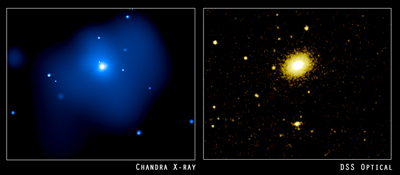
Dark matter continues to confound astronomers, as NASA's Chandra X-ray Observatory demonstrated with the detection of
an extensive envelope of dark matter around an isolated elliptical galaxy. This discovery conflicts with optical data that suggest a dearth of dark matter around similar galaxies, and raises questions about how galaxies acquire and keep such dark matter halos.
The observed galaxy, known as NGC 4555, is unusual in that it is a fairly large, elliptical galaxy that is not part of a group or cluster of galaxies. In a paper to be published in the November 1, 2004 issue of the Monthly Notices of the Royal Astronomical Society, Ewan O'Sullivan of the Harvard-Smithsonian Center for Astrophysics in Cambridge, MA and Trevor Ponman of the University of Birmingham, United Kingdom, use the Chandra data to show that
the galaxy is embedded in a cloud of 10-million-degree-Celsius gas.
Either the galaxies observed by Romanowsky and colleagues have lost their dark matter halos through earlier interactions with other galaxies, or their dark matter halos are much more extended, or they formed without dark matter halos.
The first option is possible for the galaxies in groups, but very unlikely for the isolated galaxy. The second and third options are still open, but would require a modification - perhaps a major modification - of the cold dark matter theory of galaxy formation.
http://chandra.harvard.edu/press/04_rel ... 02604.html
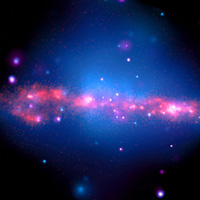
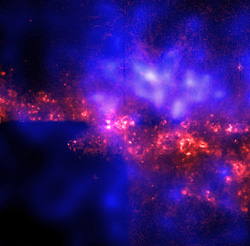
The first unambiguous evidence for
a giant halo of hot gas around a nearby, spiral galaxy much like our own Milky Way was found by astronomers using NASA's Chandra X-ray Observatory. This discovery may lead to a better understanding of our own Galaxy, as well the structure and evolution of galaxies in general.
While previous X-ray satellites have detected extended X-ray emission from this and other spiral galaxies, because of Chandra's exceptional resolution this is the first time that astronomers were able to separate the individual X-ray sources from the diffuse halo. Chandra found
the diffuse halo of X-ray gas to be radiating at a temperature of almost 3 million degrees and extending some 25,000 light years from the galactic plane.
The Chandra image reveals
a halo of hot gas that extends for approximately 25,000 light years above the disk of the galaxy.
One important feature of the X-ray emission from NGC 4631 is that it closely resembles the overall size and shape seen in the radio emission from the galaxy. This indicates that there may be a close connection between the outflows of hot gas, seen in X-rays, and the galaxy's magnetic field, revealed by radio emission.
The Hubble image of NGC 4631 shows
filamentary, loop-like structures enclosing enhanced X-ray-emitting gas and emanating from regions of recent star formation in the galaxy's disk. These data clearly show the hot gas is heated by clusters of massive stars and is now expanding into the halo of the galaxy.
http://chandra.harvard.edu/press/01_rel ... 71901.html

The first suggestion of galactic mayhem in this cluster came in 1994 when the Very Large Array radio telescope near Socorro, N.M., detected an unusual number of radio galaxies in the cluster, called Abell 2125. Radio sources trace both star formation and the feeding of central black holes in galaxy clusters. The radio observations also showed that
C153 stood out from the other galaxies as an exceptionally powerful radio source.
Keel's team began an extensive program of further observations to uncover details about the galaxies. "This was designed to see what the connection could possibly be between events on the 10-million-light-year scale of the cluster merger and what happens deep inside individual galaxies," says Keel.
X-ray observations from the ROSAT satellite (an acronym for the Roentgen Satellite) demonstrated that
the cluster contains vast amounts of 36-million-degree Fahrenheit (20-million-degree Kelvin) gas that envelops the galaxies. The gas is concentrated into two main lumps rather than smoothly distributed across the cluster, as is more commonly the case.
Astronomers then trained NASA's Hubble Space Telescope (HST) onto C153 and resolved
a bizarre shape. They found that the galaxy looks
unusually clumpy with many young star clusters and chaotic dust features. Besides the disrupted features in the galaxy's disk, HST also showed that the light in the tail is mostly attributed to recent star formation, providing a direct link to the stripping of the galaxy as it passed through the cluster core. Gas compressed along the galaxy's leading edge, like snow before a plow, ignited a firestorm of new star birth. Evidence of recent star formation also comes from the optical spectrum obtained at the 10-meter Gemini North telescope in Hawaii. The spectrum allows the researchers to estimate the time since the most recent burst of star formation.
This conclusion was further bolstered when the Mosaic camera on Kitt Peak's Mayall telescope found
a very long tail of extended gas coming off the galaxy. The tail was apparently generated in part by
a hurricane of stellar winds boiling off the new star-birth regions and being blown backwards as the galaxy streaks through the surrounding hot gas of the cluster.
The Gemini spectroscopic observations show t
he stars are in a regular pattern of orbital motion around the center, as usual for disk galaxies. However, there are
multiple widespread clouds of gas moving independently of the stars. "This is
an important clue that something beyond gravitational forces must be at work, since stars and gas respond the same way to purely gravitational forces," says Keel. "In other words, the galaxy's gas doesn't know what the stars are doing."
NASA's Chandra X-ray Observatory discovered that
the cooler clouds detected with optical telescopes and an associated radio feature are embedded in a much larger multimillion-degree trail of gas. Chandra's data indicate that this hot gas was probably enriched in heavy elements by the starburst and driven out of the galaxy by its supersonic motion through the much larger cloud of gas that pervades the cluster.
http://chandra.harvard.edu/press/04_rel ... 10604.html
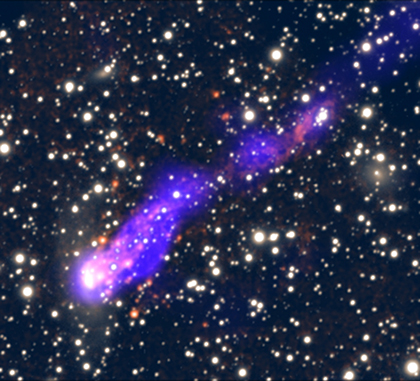
The comet-like tail was observed in X-ray light with NASA's Chandra X-ray Observatory and in optical light with the Southern Astrophysical Research (SOAR) telescope in Chile.
The feature extends for more than 200,000 light years and was created as gas was stripped from a galaxy called ESO 137-001 that is plunging toward the center of Abell 3627, a giant cluster of galaxies.
"This is one of the longest tails like this we have ever seen," said Ming Sun of Michigan State University, who led the study. "And, it turns out that this is a giant wake of creation, not of destruction."
The gas that formed the orphan stars was stripped out of its parent galaxy by the pressure induced by
the motion of the galaxy through the multimillion degree gas that pervades the intergalactic space of the galaxy cluster. Eventually most of the gas will be scoured from the galaxy, depleting the raw material for new stars, and effectively stopping further star formation in the galaxy.
http://chandra.harvard.edu/press/07_rel ... 92007.htmlThe illusion from which we are seeking to extricate ourselves is not that constituted by the realm of space and time, but that which comes from failing to know that realm from the standpoint of a higher vision. -L.H.
-
MGmirkin
- Moderator
- Posts: 1667
- Joined: Thu Mar 13, 2008 11:00 pm
- Location: Beaverton, Oregon, USA
-
Contact:
Unread post
by MGmirkin » Mon Jun 23, 2008 10:21 am
Something beyond the force of gravity is at work... The gas doesn't know or care what he stars are doing. Priceless!
Could it be electric fields / currents? The raw electric force of charged particles involved in dynamic electrical processes will tend to dwarf the gravitational interaction. Hence why charged particles "rain upward" on the sun (then eventually rain back down the other side of the circuit)... Etc.
~Michael Gmirkin
"The purpose of science is to investigate the unexplained, not to explain the uninvestigated." ~Dr. Stephen Rorke
"For every PhD there is an equal and opposite PhD." ~Gibson's law
-
StefanR
- Posts: 1371
- Joined: Sun Mar 16, 2008 8:31 pm
- Location: Amsterdam
Unread post
by StefanR » Mon Jun 23, 2008 11:51 am
The Chandra image reveals a halo of hot gas that extends for approximately 25,000 light years above the disk of the galaxy. One important feature of the X-ray emission from NGC 4631 is that it closely resembles the overall size and shape seen in the radio emission from the galaxy. This indicates that there may be a close connection between the outflows of hot gas, seen in X-rays, and the galaxy's magnetic field, revealed by radio emission.
The Hubble image of NGC 4631 shows filamentary, loop-like structures enclosing enhanced X-ray-emitting gas and emanating from regions of recent star formation in the galaxy's disk. These data clearly show the hot gas is heated by clusters of massive stars and is now expanding into the halo of the galaxy.
I found this part also quite amusing. So many hints and then still make a conclusion that's... well...hot gas.
The illusion from which we are seeking to extricate ourselves is not that constituted by the realm of space and time, but that which comes from failing to know that realm from the standpoint of a higher vision. -L.H.
-
MGmirkin
- Moderator
- Posts: 1667
- Joined: Thu Mar 13, 2008 11:00 pm
- Location: Beaverton, Oregon, USA
-
Contact:
Unread post
by MGmirkin » Mon Jun 23, 2008 4:55 pm
Quite!
"Filamentary" "hot gas" "related to the magnetic field of the galaxy" ... associated with "radio" and "x-ray" emission regions ...
C'mon, put it together! At the temperatures they talk about, it's plasma. Charged particles flow along magnetic field lines, and in fact, "currents" generate field lines of their own... Currents in plasma often tend to adopt filamentary structures. Synchrotron radiation whatnow? But they apparently didn't hear it from me...
Cheers,
~Michael Gmirkin
"The purpose of science is to investigate the unexplained, not to explain the uninvestigated." ~Dr. Stephen Rorke
"For every PhD there is an equal and opposite PhD." ~Gibson's law
-
junglelord
- Posts: 3693
- Joined: Mon Mar 17, 2008 5:39 am
- Location: Canada
Unread post
by junglelord » Mon Jun 23, 2008 5:00 pm
Your starting to sound like a plasma physicist...

If you only knew the magnificence of the 3, 6 and 9, then you would have a key to the universe.
— Nikola Tesla
Casting Out the Nines from PHI into Indigs reveals the Cosmic Harmonic Code.
— Junglelord.
Knowledge is Structured in Consciouness. Structure and Function Cannot Be Seperated.
— Junglelord
-
Solar
- Posts: 1372
- Joined: Mon Mar 17, 2008 3:05 am
Unread post
by Solar » Tue Jun 24, 2008 2:49 am
"Our laws of force tend to be applied in the Newtonian sense in that for every action there is an equal reaction, and yet, in the real world, where many-body gravitational effects or electrodynamic actions prevail, we do not have every action paired with an equal reaction." — Harold Aspden
-
StefanR
- Posts: 1371
- Joined: Sun Mar 16, 2008 8:31 pm
- Location: Amsterdam
Unread post
by StefanR » Tue Jun 24, 2008 4:23 am
davesmith_au wrote:*Voorwerp* ... pardon me!

Sounds like something and old person lets escape from their back passage...

Well, Dave seemed to be quite right. It not only sounds that way, it looks like it too, according to mainstream. Now we only have to find the match that ignited it or a burned back passage.


I think I will go for the match.

Coming back for a moment to enlightening mainstream verbiage (thank you GreyCloud

) from the end of the previous page:
New observations of our nearest neighbouring radio galaxy, Centaurus A, (10 million light years away in the southern sky) show intense X-rays in places where the fast-moving jet is apparently running into the gas and stars that make up the galaxy.
Only a small minority of galaxies have powerful jets of electrically charged particles but, where they are present, they can have profound effects on the galaxies they inhabit.The orbiting observatory Chandra have discovered that X-ray emission from jets is also common. The X-rays come from electrons carrying large amounts of energy - comparable with the energies reached in the accelerators used in particle physics experiments on Earth.
The radio observations, taken between 1991 and 2002, showed that parts of the jet are moving away from the centre of the galaxy at speeds of about half the speed of light. However, the regions of the jet that are emitting the most X-rays were stationary.
My question is this, in what way is this comparable with aurora-mechanisms? Electrons down, ions up, current structures, quantified wave/radiation emmisions?
As the x-ray images combined with radio-images seem to demark the plasma structures making up the galaxies in the above pictures would it be strange to make a link in a certain way with phenomena on a whole different scale? :
Intermittently Flowing Rivers of Quantized Magnetic Flux
One of the major unsolved puzzles in superconductivity is the nature of the motion of penetrating flux lines. Magnetic flux enters a clean type II superconductor in the form of a regular triangular lattice of quantized magnetic flux lines (also known as vortices, since electrical currents whirl around each flux line). When this lattice is forced to move, by applying either an electric or a varying magnetic field, it maintains its regular periodic structure. The dynamics of this lattice of flux lines become more complicated when it is forced to move inside a disordered sample with pinning sites that can temporarily trap vortices. As the external magnetic field is increased, additional flux lines are forced inside the sample where their motion is impeded by defects. When pinning is weak relative to the driving force, the array of flux lines flows smoothly, with some minor distortions, and behaves as an elastic medium (that is, like a flowing rubber sheet). If the pinning forces are very strong, the flux lattice remains immobilized. In the poorly understood intermediate regime, when pinning and driving forces are comparable, vortex motion is not expected to remain elastic, but to become plastic---where parts of the flux lattice break loose from the rest.
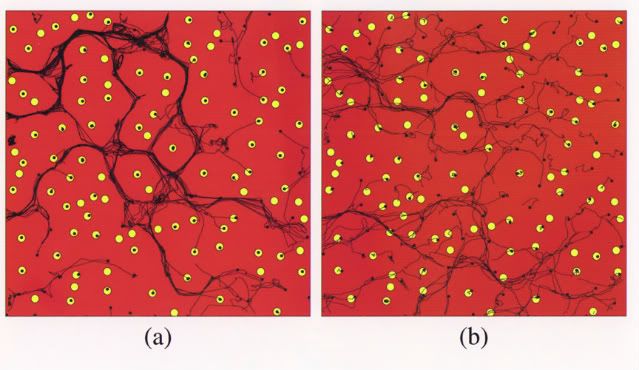
In this issue of Science, Tonomura and collaborators (1) present direct evidence of plastic flow of flux lines in a superconductor. Their experiments provide a striking motion picture of the onset of vortex motion that vividly illustrates the existence of flowing "rivers" of quantized magnetic flux that intermittently form, freeze, and reappear at different locations in the sample. These rivers flow around "islands" (or domains) of flux lines which are temporarily trapped by the pinning sites. The shape and size of these temporarily frozen islands abruptly change over time with every loading-unloading cycle. Movies of the phenomena (for figs. 5 and 6 on page 1393 of this issue) are available at
http://www.aaas.org/science/beyond/htm.
http://www.thunderbolts.info/wp/forum/phpB ... 4782#p4782
Simultaneous Penetration of Flux and Antiflux Dendrites in MgB2 rings

Flux dendrites with opposite polarities simultaneously penetrate superconducting, ring-shaped MgB2 films. By applying a perpendicular magnetic field, branching dendritic structures nucleate at the outer edge and abruptly propagate deep into the rings. When these structures reach close to the inner edge, where flux with opposite polarity has penetrated the superconductor, they occasionally trigger anti-flux dendrites. These anti-dendrites do not branch, but instead trace the triggering dendrite in the backward direction. Two trigger mechanisms, a non-local magnetic and a local thermal, are considered as possible explanations for this unexpected behaviour. Increasing the applied field further, the rings are perforated by dendrites which carry flux to the center hole. Repeated perforations lead to a reversed field profile and new features of dendrite activity when the applied field is subsequently reduced.

Flux and temperature distribution produced by vortex dynamics simulations
White dots: individual vortices;
Red: regions of enhanced temperature due to vortex motion
Green: traces of recently moving vortices
http://www.thunderbolts.info/wp/forum/phpB ... 4783#p4783
Do you get my drift?

The illusion from which we are seeking to extricate ourselves is not that constituted by the realm of space and time, but that which comes from failing to know that realm from the standpoint of a higher vision. -L.H.
-
junglelord
- Posts: 3693
- Joined: Mon Mar 17, 2008 5:39 am
- Location: Canada
Unread post
by junglelord » Tue Jun 24, 2008 5:35 am
My question is this, in what way is this comparable with aurora-mechanisms? Electrons down, ions up, current structures, quantified wave/radiation emmisions?
As the x-ray images combined with radio-images seem to demark the plasma structures making up the galaxies in the above pictures would it be strange to make a link in a certain way with phenomena on a whole different scale? :
My sentiments exactly...
quantum coherent charged entangled systems are expressed the same at both the quantum level and the galactic level.
As I describe them, coherent and incoherent systems are dominated by different sets of physical laws. With the incoherent systems that we see all around us, time is one-directional. And things that come apart don't spontaneously come together again. And the inertia--of the billiard ball, for example--increases linearly with the number of atoms. With coherent systems, on the other hand, time is two-directional, and inertia increases with the square of the number of elements. In a superconducting magnet, the electron inertia increases with the square of the number of electrons. That's foreign to Newtonian thinking, which is why Feynman had trouble with it. A coherent system is not more real, but it is much more pure and fundamental. "Coherence" seems comparable to electricity--it has existed forever.
http://freespace.virgin.net/ch.thompson ... erMead.htm
If you only knew the magnificence of the 3, 6 and 9, then you would have a key to the universe.
— Nikola Tesla
Casting Out the Nines from PHI into Indigs reveals the Cosmic Harmonic Code.
— Junglelord.
Knowledge is Structured in Consciouness. Structure and Function Cannot Be Seperated.
— Junglelord
-
StefanR
- Posts: 1371
- Joined: Sun Mar 16, 2008 8:31 pm
- Location: Amsterdam
Unread post
by StefanR » Sat Jun 28, 2008 3:32 pm
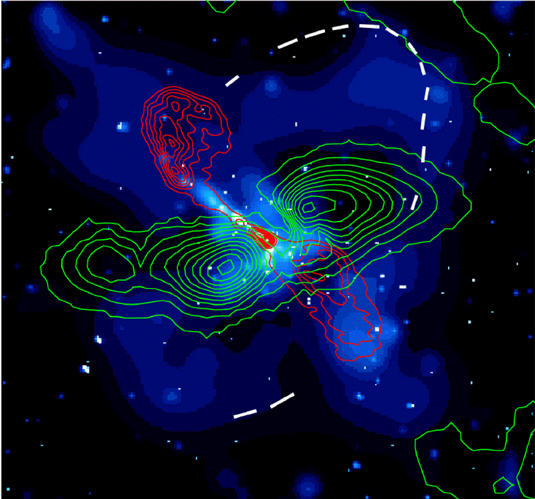
Cen A HRC-I X-ray Image
Cen A HRC-I X-ray image (dark blue) superimposed with the VLA radio
continuum map of the inner jet lobes (red contours), and the VLA radio
21-cm line HI gas emission (green contours). The white dashed line is a
schematical outline of an optical arc-like shell.
http://chandra.harvard.edu/photo/2002/0157/more.htmlThe illusion from which we are seeking to extricate ourselves is not that constituted by the realm of space and time, but that which comes from failing to know that realm from the standpoint of a higher vision. -L.H.
-
StefanR
- Posts: 1371
- Joined: Sun Mar 16, 2008 8:31 pm
- Location: Amsterdam
Unread post
by StefanR » Sat Jun 28, 2008 3:40 pm
Discovery of Gamma Rays from the Edge of a Black Hole
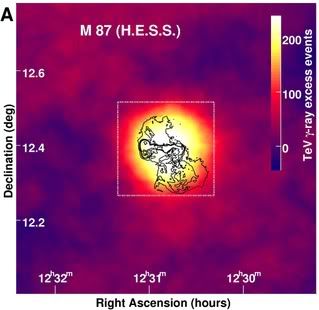
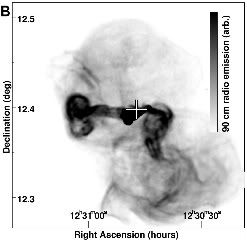
The radio galaxy M 87 seen at very high energies by H.E.S.S. (left or top panel (A), colour scale). The emission seems extended which is, however, explained by the measurement accuracy of the telescopes. A much stronger constraint on the size of the emission region can be derived from the measured variability of the VHE gamma radiation (see text). The black lines reflect the structure of M 87 at radio wave-lengths.
Right or bottom panel (B): Zoom to dotted square in left panel. The radio galaxy M 87 as seen at radio wave lengths, which corresponds to energies 19 orders of magnitude lower than the VHE gamma radiation. The position of the maximum emission of the VHE gamma radiation is also given (cross). (Radio data adapted from F.N. Owen et al.).
http://www.mpi-hd.mpg.de/hfm/HESS/publi ... ase_E.html
Each month a TeV gamma ray source investigated with the H.E.S.S. telescopes is featured
http://www.mpi-hd.mpg.de/hfm/HESS/publi ... _index.htmThe illusion from which we are seeking to extricate ourselves is not that constituted by the realm of space and time, but that which comes from failing to know that realm from the standpoint of a higher vision. -L.H.
Who is online
Users browsing this forum: No registered users and 2 guests










